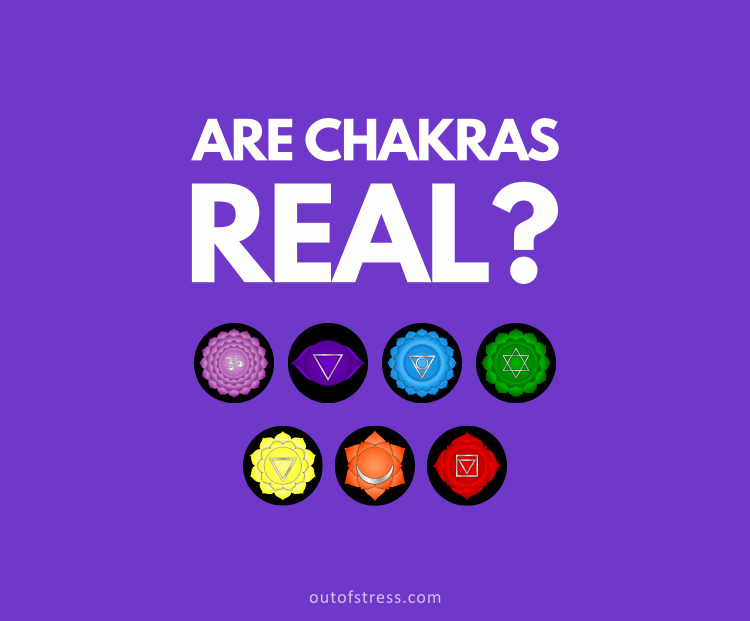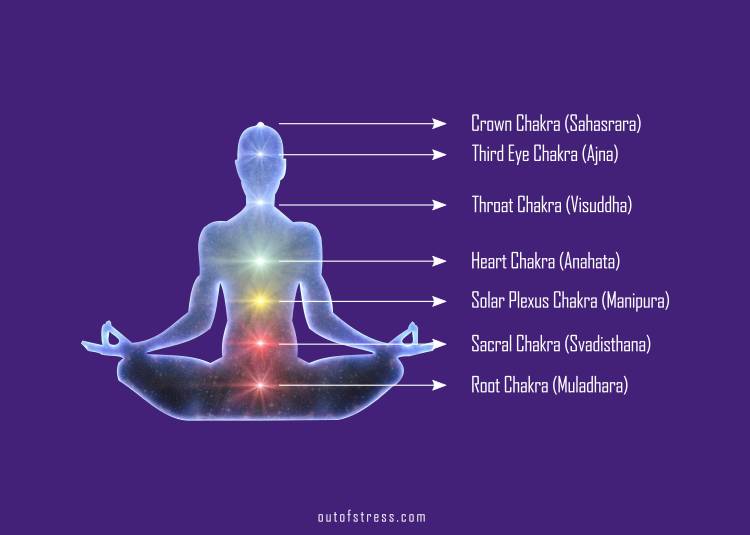
Those diving into New Age spirituality will hear the word “chakra” quite often. However, since you can’t see your chakras – these colorful balls of energy which rest inside you – it’s easy to believe that they aren’t real.
Chakras operate as part of the subtle body: that means that they can be sensed only when we clear out our mental clutter and tune into them directly, but they can’t be seen or felt as strongly as we could feel a stomach ache, for example.
Below, let’s understand what the chakras are, and how to determine for yourself whether or not they are “real”.
What exactly are the Chakras?
Chakra is the Sanskrit word for “wheel”. As such, our seven chakras are spinning wheels of energy located from the base of our spine to the crown of our head.

These energy wheels are known to both influence and be influenced by the areas of the body in which they sit. Beyond the physical, though, our chakras also play an important give-and-take with our mental and emotional wellbeing.
Everybody has seven chakras. If the chakras become blocked with stagnant energy, we can experience physical ailments such as digestive issues or headaches; we can also experience emotional changes, such as lack of motivation, or excessive anger, to name a few examples.
When our chakras are open and aligned, on the other hand, our physical, mental, and emotional states run smoothly in balance.
Are Chakras real?
Let’s look at the various systems and functionalities that chakras represent in your body and then decide if or not they are real.
1. Chakras and the endocrine system
Yogis in ancient times knew that our chakras govern physical areas of our bodies; now, we know that the physical areas that these ancient practitioners spoke of are part of our endocrine system, which controls the body’s hormone levels.
Each chakra aligns with an endocrine gland or glands, which release hormones into our bloodstream. These glands regulate everything from reproduction to sleep. Here’s a brief outline of which gland or glands each chakra influences:
- Root chakra: reproductive glands
- Sacral chakra: adrenal glands
- Solar plexus chakra: pancreas
- Heart chakra: thymus gland
- Throat chakra: thyroid gland
- Third eye chakra: pituitary gland
- Crown chakra: pineal gland
An imbalance in any chakra can cause imbalances in the glands which it regulates. For example: a blocked sacral chakra can cause the adrenal glands to malfunction, leading to adrenal fatigue (i.e. lethargy).
Chakras and the organs
In addition, our chakras influence our other bodily systems; each chakra is connected with multiple organs in the area which the chakra sits. Similar to the way the chakras influence the endocrine system, if any chakra is imbalanced, the organs which it influences may present with dysfunction.
Here’s a quick review of the main organs which each chakra governs:
- Root chakra: kidneys
- Sacral chakra: reproductive organs, gall bladder, spleen
- Solar plexus chakra: stomach, liver, pancreas
- Heart chakra: heart and lungs
- Throat chakra: esophagus, vocal chords, respiratory organs
- Third eye chakra: eyes
- Crown chakra: brain and spinal cord
To name just a few examples (out of many), if the throat chakra becomes blocked, one may experience a sore throat; in addition, blockage in the solar plexus chakra can cause acid reflux.
3. Chakras and mental/emotional functioning
As we saw earlier, the seven chakras regulate not only your physical body, but also your mental and emotional state. The way the chakras regulate your emotions is a little less straightforward than their governance of the organs and glands, but it’s nonetheless intuitive. Let’s go over what mental and emotional systems each chakra influences:
- Root chakra: stability, safety, groundedness
- Sacral chakra: creativity and feelings
- Solar plexus chakra: willpower, motivation, and boundaries
- Heart chakra: love and empathy
- Throat chakra: voice and personal truth
- Third eye chakra: intuition
- Crown chakra: awareness and connection with Spirit
So, it follows that a blocked heart chakra– for example – can cause one to lack empathy. On the other hand, though, an overactive heart chakra can create overactive, boundaryless empathy.
Are the chakras real, then? I’ll encourage you to test that out for yourself! Notice if you feel an imbalance in any of the above areas. Then, take a few weeks or months to work on the associated chakra in earnest (using the method which we’ll describe below, if it resonates). Notice what happens as a result: did your imbalance begin to make positive progress?
What’s the differences between Qi, Prana, and Chakras?
If you’ve studied Yoga or Qigong, or even just been to a class, you may have heard these three terms thrown out there: Qi, Prana, and the chakras. You may be wondering: what’s the difference? Are these all referring to the same thing?
First of all, let’s clarify that Qi (or Chi) and Prana are generally recognized as the same thing, but they originate from separate traditions. Qi and Prana both refer to the life force energy which flows through our bodies. Qi, though, is associated with Qigong, and it comes from ancient Chinese medicine; Prana, on the other hand, comes from Yoga and ancient Indian medicine.
Second, it helps to note that the chakras are traditionally tied in with Yoga and Indian Ayurvedic medicine; at the time of its ancient origin, the chakras were not a part of Qigong or Chinese medicine. However, since Qi and Prana are essentially the same, we’ll tie them both in here.
Qi and Prana are not the same thing as chakras. They are interdependent on each other, though! This connection involves the nadis, which we’ll look at in the next paragraph; for now, simply remember that Prana flows through the nadis, in order to energetically connect the seven chakras together.
What’s the difference between the Chakras, Nadis, and Meridians?
Once again, there’s a distinction to make here between ancient Chinese and ancient Indian medicine: the nadis originated from India, whereas the meridians came from China. Similar to the distinction between Qi and Prana, nadis and meridians are practically the same thing. Energy (Qi or Prana) is said to flow through the nadis, or meridians, which are like energy highways running through the body.
So, how do the chakras interact with these streams of energy? First of all, let’s point out that there are said to be thousands of nadis, but the most important are the six main nadis: ida, pingala, sushumna, brahmani, chitrani, and vijnani. The ida, pingala, and sushumna nadis intertwine their way up the spine, like a strand of DNA. The seven points at which these three nadis converge are where each of the seven chakras rest.
If we were to speak of meridians, on the other hand: there are twelve main meridians, rather than six. The meridians, however, interact with the chakras just like the nadis do (since both involve energy flow). Although the meridians don’t line up perfectly with the chakras, since they come from different ancient traditions, they do still influence each other; blocked meridians can lead to chakra blockage, and vice versa.
How to use meditation to connect to your Chakras?
So, how should you keep your chakras aligned and clear? Among other rituals, meditation is one of the primary ways to align your chakras. The simplest way to meditate on the chakras is to visualize the color that each chakra corresponds with, in order:
- Root chakra: red
- Sacral chakra: orange
- Solar plexus chakra: yellow
- Heart chakra: green
- Throat chakra: light blue
- Third eye chakra: indigo
- Crown chakra: violet
To practice this visualization, sit comfortably and close your eyes. Taking a minute or so per chakra, visualize the color that it corresponds with; start with the root chakra, and work your way to the crown one at a time. This visualization is best practiced as a daily maintenance ritual, to keep your chakras open and healthy.
You can also chant mantras specific to each mantra while you meditate to get the maximum benefits.
Summing it up
By aligning the chakras through meditation, you’ll enjoy a more aligned physical, mental, emotional, and spiritual state. You’ll feel more physically and emotionally stable, more creative, and more assertive; you’ll also enjoy a balanced sense of empathy, be able to speak your truth more easily, and be more in tune with your intuition, your spirit guides, and God.
Again, if you’re wondering whether chakras are real, do your own personal research! Follow the tips laid out here to discover whether any of your chakras are blocked, and how you can bring them into alignment. You may just find that your chakras are, in fact, an integral piece of your overall physical, mental, and emotional wellbeing!







